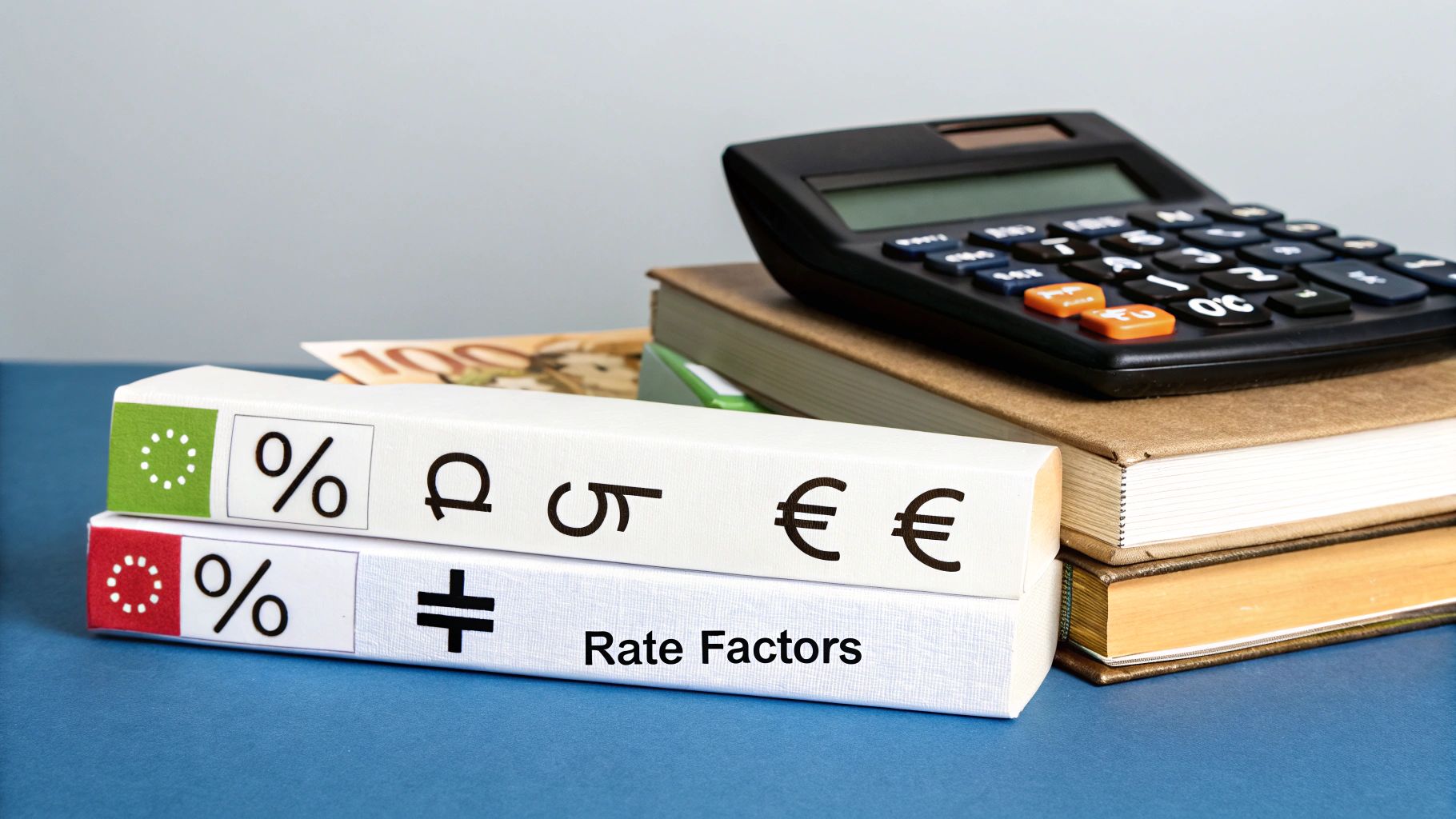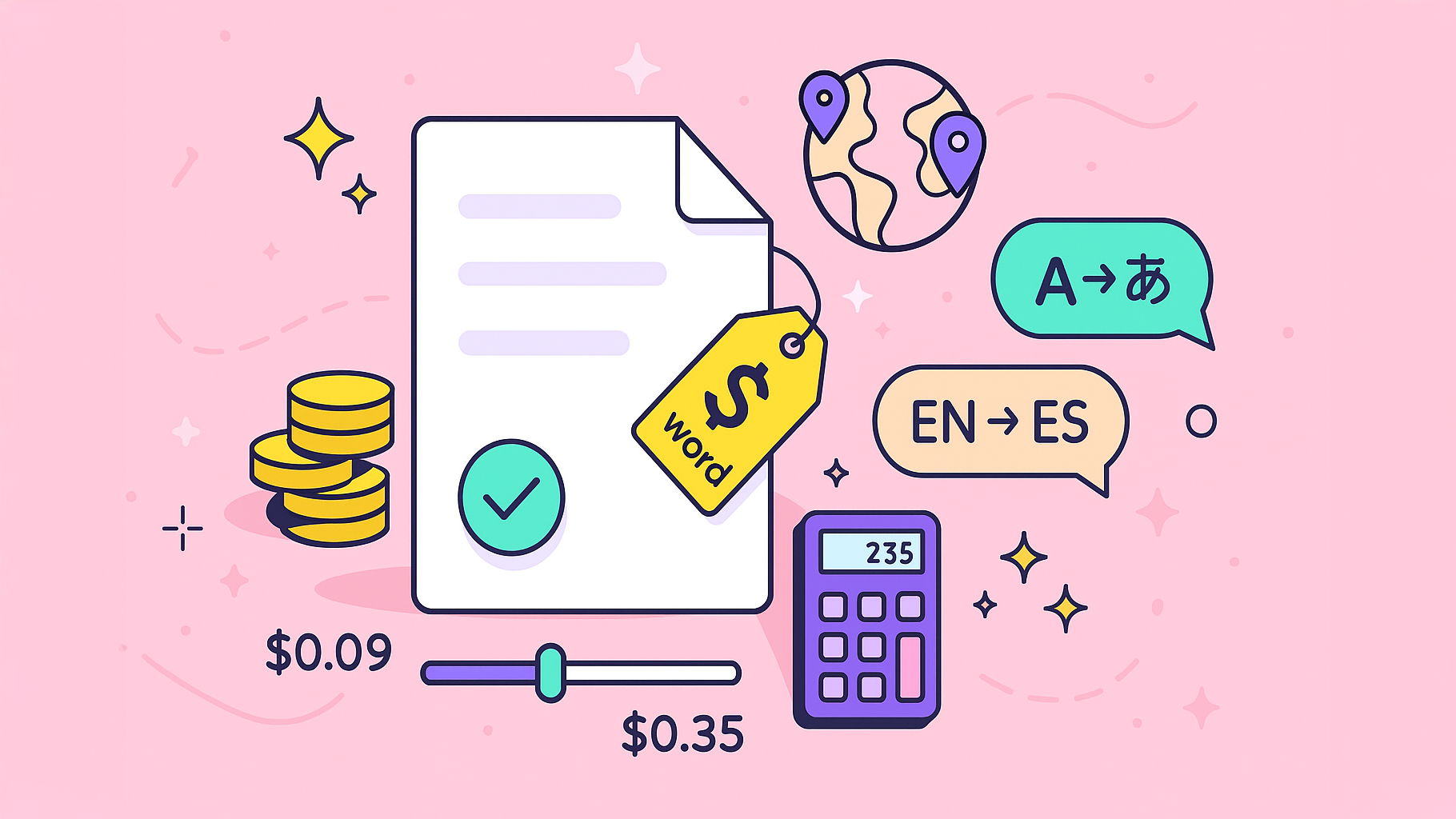When you start looking into professional translation, you’ll quickly find that paying by the word is the standard way of doing things. The going rate usually falls somewhere between $0.09 and $0.35 per word. Where your project lands in that range depends on the usual suspects: the languages involved, what kind of content it is, and how fast you need it back.
This per-word model is popular for a reason—it’s transparent and easy to predict.
What Are Typical Translation Prices Per Word?

Think of buying translation services like buying fabric by the yard. It’s a clear, measurable unit that both you and the provider can agree on from the start. This approach takes all the guesswork out of hourly rates, giving you a straightforward way to budget.
The math is simple: Word Count x Per-Word Rate = Total Price. It’s this clarity that has made the per-word model the backbone of the translation industry.
A Snapshot of Average Rates
The final price tag can swing quite a bit depending on what you need. For example, highly technical fields like healthcare, IT, and engineering demand specialized knowledge. There’s no room for error, so these projects command higher rates to reflect the need for absolute precision. Technical documents often land in the $0.12 to $0.15 per-word range, sometimes even higher, because you’re paying for an expert’s deep understanding of the subject. You can dig deeper into how complexity impacts cost by checking out these insights on translation pricing.
To give you a better feel for what to expect, here’s a quick look at typical price ranges for different translation needs.
Average Translation Rates At A Glance
This table breaks down common per-word costs to help you get a baseline for your budget.
| Translation Type | Average Price Per Word (USD) | Best For |
|---|---|---|
| General Content | $0.09 – $0.14 | Blog posts, internal communications, general emails |
| Marketing & Advertising | $0.15 – $0.25 | Websites, brochures, social media, ad copy |
| Technical & Specialized | $0.18 – $0.30+ | Medical records, legal contracts, user manuals |
| Certified/Legal | $0.20 – $0.35+ | Official documents, patents, court filings |
Keep in mind, this is just a starting point. As we’ll get into, a few key factors can push these numbers up or down. But for now, this should give you a solid foundation for estimating what your investment in professional translation might look like.
Key Factors That Influence Translation Costs
Understanding the baseline per-word prices for translation is a great starting point, but those rates are far from set in stone. Think of a translation quote like a car’s sticker price—a base model is one thing, but options and special features will adjust the final cost. Several key variables work together to determine whether your project lands on the lower or higher end of that pricing spectrum.
The single biggest factor is the language pair, which is simply the combination of the source and target languages. Basic economics of supply and demand are at the heart of this.
The per-word pricing model really took off as globalization and the internet boom created a massive demand for translation beyond just literary and diplomatic texts. This shift led to more dynamic pricing that reflects a language’s complexity, the number of available translators, and regional economic factors. For example, translating from English to Spanish tends to be less expensive simply because there’s a large pool of qualified translators. On the other hand, finding an expert to translate from Mandarin to Swahili is much harder, so you can expect to pay a premium for that scarcity. For a deeper dive, you can find detailed breakdowns of translation service rates on ulsweb.com.
Content Complexity and Specialization
Not all words are created equal. The complexity of your source material is another major cost driver. Translating a simple internal memo is one thing; tackling a dense pharmaceutical patent or a complex legal contract is a completely different ballgame.
Specialized content demands a translator who isn’t just a language expert but also a subject matter expert (SME). That dual expertise is non-negotiable for accuracy and, as you’d expect, it commands a higher price.
Here’s a quick breakdown of how complexity affects the cost:
- General Content: Think blog posts or customer emails. The language is straightforward with no specific jargon. This is the most affordable type of content to translate.
- Technical Content: This requires a translator with a background in a specific field like engineering, IT, or science. These documents are packed with terminology that has to be spot-on.
- Creative Content: This includes marketing slogans or ad copy where a literal, word-for-word translation just won’t work. This kind of project requires “transcreation” to adapt the message’s cultural nuances and emotional impact—a highly skilled and more expensive service.
Urgency and Turnaround Time
Time is money, and nowhere is that truer than in the translation world. Standard per-word rates are calculated with a reasonable turnaround time in mind. But if you need a project finished overnight or over a weekend, you should expect to pay a rush fee.
These surcharges can add anywhere from 25% to 100% on top of the base rate. This premium is what compensates translators for dropping everything and working outside of normal business hours to hit your tight deadline. Planning your translation needs in advance is one of the easiest ways to keep your budget in check. For businesses, having an efficient system is critical, which is why you might find our guide on creating an automatic translation report for business helpful for streamlining your workflows.
Document Format and Other Factors
Finally, don’t overlook the format of your source document. A clean Microsoft Word file is the easiest for translators to work with. But things get more complicated with files like PDFs, scanned images, or intricate PowerPoint presentations where text is embedded in graphics.
This kind of content requires extra time for someone to extract and reformat the text before the translation can even begin. This additional pre-processing work is often billed separately or will result in a higher overall project fee. Other requirements, like needing a certified translator for official legal documents, will also add to the final cost.
Specialized Vs. General Translation Price Differences

Not every translation project is cut from the same cloth, and the price per word will absolutely reflect that. It’s a lot like hiring a doctor. You’d see your family GP for a common cold, but you’d want a top neurosurgeon for brain surgery. The skill, the stakes, and the cost are in completely different leagues.
Translation works the exact same way.
General translation handles everyday content. Think internal memos, simple blog posts, or social media updates where the language is pretty straightforward. But specialized translation dives into the deep end with complex, high-stakes material—legal contracts, medical device manuals, or dense engineering patents. This is when you call in the neurosurgeon of the translation world.
Why Specialization Commands a Higher Rate
A specialized translator is so much more than a linguist; they’re a subject matter expert (SME). This powerful combination of skills is precisely why their rates are higher.
A generalist could probably translate the words in a patent application correctly. But only an expert with a background in patent law or a specific engineering field can nail the precise terminology and subtle nuances that make the document legally binding and technically sound. Get it wrong, and the consequences can be catastrophic—from a multi-million dollar patent being invalidated to a patient being harmed by a misunderstood medical manual.
When you hire a specialist, you aren’t just paying for words to be swapped between languages. You’re investing in precision and mitigating massive risk.
A specialized translator’s real value is their ability to navigate complex jargon that even a native speaker outside that field would struggle with. The higher prices for translation per word directly reflect the years of advanced education and hands-on experience required to master both a language and a highly technical discipline.
Qualifications of a Specialized Translator
So, what really sets these experts apart? It’s not just about being fluent. Specialized translators bring a whole different set of credentials to the table that prove their deep expertise.
- Advanced Degrees: It’s common for them to have a Master’s, PhD, or professional degree in the field they translate for, like law, finance, or medicine.
- Industry Certifications: They might hold specific, hard-to-get certifications, like those from the American Translators Association (ATA), which offers rigorous tests for specialized areas.
- Demonstrated Experience: Often, the most critical qualification is a proven track record of successful projects within that specific niche.
You’re paying for this deep well of knowledge. This is why trying to apply a one-size-fits-all budget to a critical project is a recipe for disaster. While tools can certainly help with basic tasks, they just don’t have the contextual brainpower for this kind of work.
For example, integrating something like Google Translate for Jira and JSM can be a game-changer for handling high-volume, general customer support tickets. But it is not—and was never meant to be—a substitute for a human expert on a complex legal or technical document. Understanding this difference is the key to budgeting effectively and ensuring your high-stakes projects succeed.
Exploring Pricing Models Beyond Per Word Rates
While the per-word rate is the bread and butter of the translation industry, it’s not the only way to slice the pricing pie. Getting a handle on the alternatives is crucial for understanding any quote you get, especially for projects that don’t neatly fit into a word-count box.
Think of it like this: you wouldn’t pay a painter by the number of brushstrokes. For some jobs, especially creative or complex ones, you need a different way to measure the effort involved. The same logic holds true in translation, where different types of work call for different pricing models.
When Hourly Rates Make More Sense
For certain projects, charging by the hour is a much better fit. This model comes into play when the translator’s effort isn’t just about typing out words. Creative work is the classic example here.
- Transcreation: This is where a translator adapts marketing slogans or ad copy to pack the same emotional and cultural punch in a new language. It’s far more like creative copywriting than a direct, literal translation.
- Complex Editing: If a document needs a heavy lift—major rewrites, deep cultural adaptation, or tricky formatting—an hourly rate accurately reflects the time and skill invested in those detailed tasks.
- Consulting: Sometimes, you just need an expert’s brainpower for a strategy session or a high-level review. That time is best measured and billed by the hour.
While standard professional translation rates in the U.S. often fall between $0.15 to $0.30 per word, hourly pricing adds another dimension. Simpler tasks might run $15-$30 per hour, but for highly specialized fields like law or medicine, you can expect an expert to charge $75 or more. You can dig into a full breakdown of these diverse translation rates on smartling.com.
Fixed Pricing for Standardized Projects
Another popular alternative is a flat-rate or per-page fee. This method is perfect for standardized, predictable documents where the content and layout are almost always the same.
Why Flat Rates Work Well
A per-page fee gives you total cost certainty right from the start. It simplifies the quoting process for everyone and is ideal for official documents that follow a consistent, well-known structure.
You’ll commonly see this for documents like:
- Birth certificates
- Marriage licenses
- Diplomas and academic transcripts
- Driver’s licenses
For these types of jobs, the translator knows exactly what they’re getting into, which lets them offer a fixed, no-surprises price.
The Rise of MTPE and Hybrid Models
Finally, a newer model has popped up alongside the growth of artificial intelligence: Machine Translation Post-Editing (MTPE). This hybrid approach blends the raw speed of AI with the critical nuance of a human expert. First, an AI tool does the initial heavy lifting, and then a human editor steps in to refine the output for accuracy, tone, and natural flow.

As this data shows, translating a rare language can easily cost more than double what a common one does, which really drives home the impact of translator supply and demand. MTPE provides a smart way to manage these costs, typically coming in at a lower price point than full human translation but delivering much higher quality than what you’d get from raw, unedited machine output.
Comparison Of Translation Pricing Models
To help you see how these different models stack up, here’s a quick comparison of the most common approaches you’ll encounter. Each has its own place, and knowing the pros and cons can help you decide what’s best for your specific project.
| Pricing Model | How It Works | Commonly Used For | Pros & Cons |
|---|---|---|---|
| Per Word | The most common model. The total cost is the word count multiplied by the agreed-upon rate. | General documents, articles, websites, books, and most standard content. | Pro: Simple, transparent, and easy to budget. Con: May not capture the full effort for creative or highly complex work. |
| Hourly | Billed based on the time the translator spends on the project. | Transcreation, complex editing, proofreading, cultural consulting, software localization. | Pro: Accurately reflects the time spent on non-textual tasks. Con: Can be harder to predict the final cost upfront. |
| Per Page / Flat Rate | A fixed price is charged for a standardized document or project. | Official documents like certificates, diplomas, licenses, and legal forms. | Pro: Complete cost certainty and simplicity. Con: Only works for highly predictable, template-based documents. |
| MTPE (Hybrid) | A machine generates the initial translation, and a human editor refines it. Priced lower than full human translation. | Large-volume content, technical manuals, internal documents where speed and cost are priorities. | Pro: Faster and more cost-effective than human-only translation. Con: Quality can vary; not suitable for high-stakes creative or marketing content. |
Ultimately, the best pricing model depends entirely on the nature of your project. By understanding these options, you’ll be much better equipped to have a productive conversation with your translation provider and ensure you’re getting fair value for the work required.
How To Budget For Your Translation Project
Alright, let’s move from theory to practice and figure out how to actually build a budget for your translation project. This doesn’t have to be a shot in the dark. At its heart, the process kicks off with a straightforward formula that gives you a solid baseline to work from.
The fundamental calculation is pretty simple:
Total Word Count x Per-Word Rate = Base Translation Cost
This little equation gives you a clear starting point. For example, say you have a 10,000-word software manual. Your translation partner quotes a rate of $0.18 per word for that type of technical content. Your initial estimate is a neat $1,800. From there, you can start layering in other factors that will shape the final price.
Calculating Your True Project Cost
A base cost is a great start, but a realistic budget needs to account for all the moving parts. These are the surcharges or, sometimes, discounts that can nudge your initial estimate up or down.
Here are the key variables you need to have on your radar:
- Complexity Surcharges: Does your content dive deep into legal or medical terminology? If it requires a specialist with specific domain expertise, expect to pay a premium for that know-how.
- Rush Fees: Need the project turned around in half the standard time? Providers will almost always add a rush fee, which can be anywhere from 25-50% of the total cost, to make a tight deadline happen.
- Formatting Fees: Is your source text locked away in a tricky format like a PDF, a scanned image, or a complex design file? You’ll likely see an extra charge for the manual labor needed to pull the text out and put it back in correctly.
Let’s go back to our software manual example. We started with a base cost of $1,800. A 30% rush fee would tack on another $540. If there’s also a $200 flat fee for handling the PDF formatting, your new estimated budget climbs to $2,540.
Getting an Accurate Word Count
To get an accurate quote, you first need an accurate word count. This is a breeze for simple Microsoft Word documents. But pulling text from other file types? That can get tricky. You might need to use an online tool or simply ask your translation partner to help you count the words on a website or inside a PDF.
When you get a quote back, look it over carefully. A professional quote will be itemized, clearly breaking down the per-word rate, any surcharges, and exactly what services are included. This kind of transparency helps you sidestep hidden costs and truly understand the prices for translation per word that add up to your total.
Smart budgeting is a critical skill, and while we’re focused on translation, understanding how to analyze costs is valuable everywhere. For anyone curious, there are plenty of general cost estimation resources online that cover different industries. The principles of breaking down costs are universal, whether you’re managing a software team or a global marketing campaign. This detailed approach to planning is part of what makes modern work more effective—similar to how some teams experiment with new schedules to boost productivity, a topic we explore in our article on the four-day work week.
Balancing Translation Cost With Quality

When you stumble upon suspiciously low prices for translation per word, a little caution is a very good thing. In the world of translation, chasing the lowest price often leads you directly to the highest long-term cost. Going with a cheap, unvetted service can backfire spectacularly, leaving you with brand-damaging mistakes that quickly erode customer trust.
The real cost of a bad translation isn’t just the money you paid for it. It’s the expensive, time-consuming headache of re-translating the entire failed project from square one—all while you’re scrambling to manage the fallout from the first botched attempt. It’s better to think of translation not as a simple line-item expense, but as a crucial investment in your global brand reputation.
Choosing a translator based on price alone is like picking the cheapest parachute. It might seem like a good deal on the ground, but you only discover its true value when it matters most.
How to Vet for Quality
So, how do you avoid these common pitfalls? You need a solid process for vetting potential translators or language service providers (LSPs). The goal is to find a true partner who delivers both quality and value, making sure your investment actually pays off. A bit of due diligence upfront can save you from major headaches and expenses down the road.
Here are a few practical steps to get you started:
- Check Industry-Specific Experience: Don’t be shy. Ask for proof that they’ve successfully handled projects in your specific field, whether it’s medical, legal, technical, or SaaS.
- Request Relevant Work Samples: Be specific. Don’t just ask for any old sample; ask to see translations they’ve done for projects similar to yours in both scope and complexity.
- Read Client Reviews and Testimonials: Dig into feedback from past clients. This is where you’ll get the real story on their reliability, communication, and the overall quality of their work.
For teams managing a high volume of customer interactions, embedding professional translation directly into your existing workflow is a game-changer. Specialized apps, for instance, can streamline all that back-and-forth communication while keeping quality high. If you want to see how this works in a real-world service desk, you can learn more about translations for Jira Service Desk.
Ultimately, by prioritizing expertise over rock-bottom prices, you protect your brand and ensure your message truly connects with your audiences, no matter where they are in the world.
Frequently Asked Questions About Translation Pricing
Even after you’ve got a handle on how translation projects are priced, a few questions tend to pop up. Let’s dig into some of the most common things people ask about the world of prices for translation per word.
Does The Per Word Price Include Proofreading?
This is a big one, and the answer is… it depends on who you’re working with. A solid, professional service usually operates on what’s known as the TEP model—Translation, Editing, and Proofreading. When you see this, the per-word rate you get should cover all three steps, giving you a final document that’s polished and ready to go.
On the other hand, some providers focus on budget-friendly options and might give you a lower, translation-only rate. In that scenario, editing and proofreading become add-ons you have to pay extra for. The best move is to always ask for a clear breakdown so you know exactly what’s in the quote.
It’s absolutely crucial to confirm if proofreading is bundled into the rate. A quote that seems cheap upfront can get expensive fast if those essential quality checks are billed separately. Getting that clarity from the start saves a lot of headaches later and ensures you get a publication-ready document.
How Do CAT Tools Affect The Price?
This is where things get interesting, especially for ongoing projects. Computer-Assisted Translation (CAT) tools, particularly those with a translation memory (TM), can be a game-changer for your budget. A TM is basically a smart database that saves every single sentence you’ve ever had translated.
When those same sentences (100% matches) or very similar ones (fuzzy matches) show up in new projects, agencies will typically give you a discount on them. The technology rewards you for consistency, and over time, it can seriously reduce your translation costs. If you want to dive deeper into this, our guide on automatic translations insights has some great information.
Why Does Translating Into A Language Cost More?
This often boils down to good old supply and demand. You’ll frequently find that translating from English into Japanese, for instance, costs more than translating from Japanese into English.
Why? It’s because there might be a much smaller pool of highly qualified, native-speaking Japanese translators available for that particular project. If those experts also happen to live in a country with a high cost of living, their rates will naturally be higher. The price is a direct reflection of how many specialized experts are available for that specific language combination.
Looking to eliminate language barriers in your customer service? resolution Reichert Network Solutions GmbH offers a powerful solution. Our Issue Translation for JSM app integrates directly into Jira Service Management, providing real-time, AI-powered translations to help your team support anyone, anywhere.
